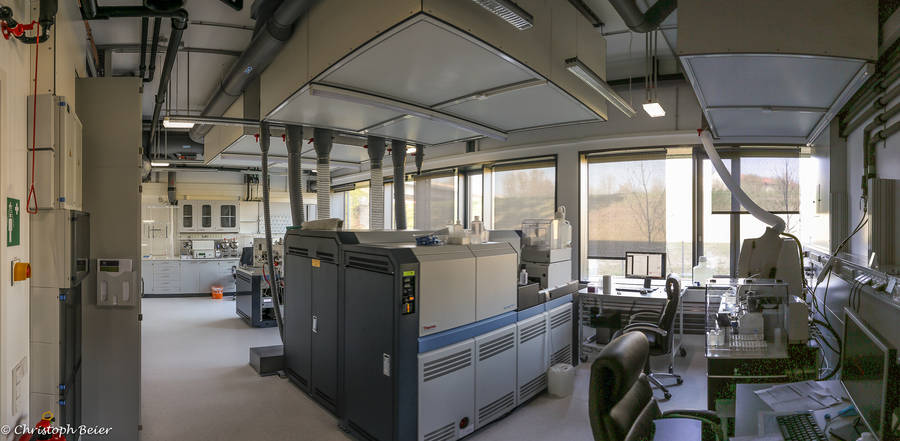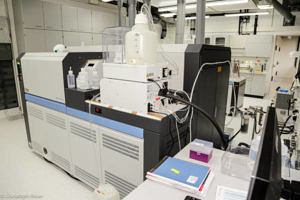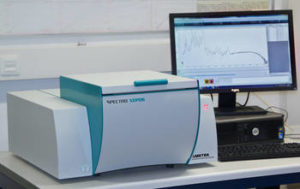Laboratory equipment
Ultrastructural analysis
The microtomography system by General Electrics/Phoenix (from 2016) is installed in a seperate laboratory building. The µCT provides high resolution cross-sections of a physical objects (3D models) without destroying the original objects. Operated by the Palaeobiology section, the µCT is in use by various disciplines including material sciences, medicine and archaeology. Please contact Christian Schulbert (0049 9131 85 24851, gzn-pal-rem@fau.de) if you want to use the µCT for your own application.
The scanning electron microscop by the company TESCAN from Brno (Brünn) is operated by the Palaeobiology section. Please contact Christian Schulbert (0049 9131 85 24851, gzn-pal-rem@fau.de) if you are interested in using the SEM.
Mineralogy
Six diffractometers are available at the GeoZentrum via the research groups in Mineralogy and Endogenous Geodynamics. They allow the following applications:
- Rietveld-supported qualitative and quantitative, temperature-supported phase analysis (G-factor)
- In-situ analysis of crystalline phases
- Microanalysis, textures, (GADDS system)
- Smallest sample quantities, kinematics (D5000 with SOLX detector)
Further information and contact details can be found on the pages of the Chair of Mineralogy and the Endogenous Geodynamics working group.
1H-time-domain nuclearmagnetic resonance (TD NMR) is a very interesting method in the field of cement chemistry due to its ability to differentiate quantitatively between different proton environments. A clear differentiation between solid (e.g. hydrogen in solid crystals), amorphous (e.g. hydrogen in amorphous gels) and liquid states (e.g. hydrogen in water) of proton bearing phases can be achieved with good time resolution during cementitious reactions. A Bruker minispec with temperature controlled probe head is available at the chair for mineralogy. Please find more information on the web pages of the research group of the Chair of Mineralogy.
An IMETER M20b measuring system is available at the Chair of Mineralogy at the GeoZentrum for recording and analysing the curing behaviour of cementitious systems under controlled humidity and temperature conditions. The penetration test method is using a cylindrical needle. The IMETER hardness Hi20 is determined at defined times during the hydration process and thus changes in the consistency of the material are continuously detected. Please find more information on the web pages of the research group of the Chair of Mineralogy.
Heat flow calorimetry enables the investigation of endothermic and exothermic reactions during cement hydration. Three high-performance isothermal 8-channel TAM Air calorimeters are also available for commercial use at the GeoZentrum. With the help of the specially designed InMixEr tools, early reactions can be measured. Further information can be found on the Mineralogy pages.
The microprobe laboratory operated by the Mineralogy group includes a JEOL JXA 8200 SuperProbe with five WDS-spectrometers. Please find more information on the web pages of the research group.
The Chair of Mineralogy provides a BET device (Belsorp Mini X from Microtrac Retsch GmbH) for the surface determination of powder samples using the Brunauer-Emmet-Teller method, as well as a Mastersizers 3000 for the analysis of particle size distribution using laser diffraction technology. Further information and contact details can be found on the Mineralogy working group page.
At the Chair of Applied Mineralogy, a STA 449 F5 Jupiter® from Netzsch is available for thermogravimetric analysis (TG) and differential thermal analysis (DTA, DSC). Thermogravimetric analysis measures the weight of a sample during a temperature treatment, whereas differential thermal analysis (DTA, DSC) measures the enthalpy changes of a sample relative to an inert reference. This allows the analyses of transformation reactions such as phase transitions. Please find more information on the web pages of the research group of the Chair of Mineralogy.
Geochemistry and trace analysis
The group of Applied Geosciences operates a state-of-the-art isotope facility for the analyses of stable isotope ratios in the liquid phase.
- Three isotope ratio mass spectrometers (IRMS) with various pheripherals for HCNO analysis for different matrices
- Two Picarro Laser isotope spectrometer for water (hydrogen and oxygen isotope ratios of H2O)
- Two laser spectrometer (Picarro and DeltaRay) for CO2 and methane
For a detailed list of analytical capabilites please refer to the website of the working group.
Water quality and water chemistry can be determined by a large variety of field and laboratory-based instruments.
- Inductively coupled plasma mass spectrometry for major ions and trace elements (Thermo iCAPQ ICP-MS)
- Ionchromatography for anions (Metrohm 930 Compact IC Flex)
- Automatic alkalinty titrator (Metrohm Eco)
- Field parameters (Hach and WTW multiparameter instruments)
- HACH digital titrators
- Groundwater sampling (submerged pump MP1)
- Discharge (SEBA MiniFlügel and FlowSens)
- mobile photospectrometer
- various gear for hydro(geo)logical field sampling
For a more detailed list please refer to the website of the working group.
The laboratory for isotopes provides three mass spectrometers for determining stable isotope abundances for carbon, nitrogen and oxygen in solid samples (carbonates, phosphates, sulphates and organic material).
Contact: apl. Prof. Dr. M. Joachimski
The GeoZentrum Nordbayern is equipped with new, purpose built metal-free Class 1000 geochemistry laboratories laboratories, and state-of-the-art magnetic sector and quadrupole mass spectrometers. These instruments are used to measure the isotope composition of elements such as Sr, Nd, Pb and Hf, as well as mass-dependent isotope variations in elements such as Mo and Sr. A quadrupole ICP-MS is used to measure trace element concentrations in geological materials. We undertake work for external users, and are happy to discuss collaborative projects. Please contact Marcel Regelous (09131 8569602, Marcel.Regelous@fau.de) for more information.

Our thermal ionisation mass spectrometer has 9 Faraday detectors and a secondary electron multiplier, and is used for the precise isotope analysis of small (10-100 nanogram) quantities of Sr, Nd and other rare-earth elements. Please contact Marcel Regelous (09131 8569602, Marcel.Regelous@fau.de) for more information.


The working group Applied Geosciences currently establishes a new laboratory facility for geomicrobiology. Already installed:
- Glove Box system
For recent updates, please refer to the website of the working group.



